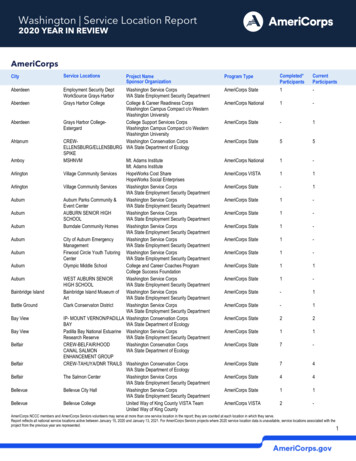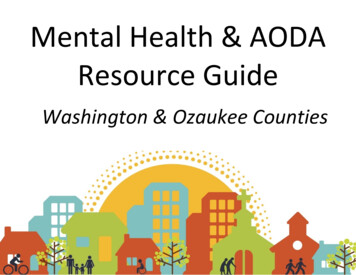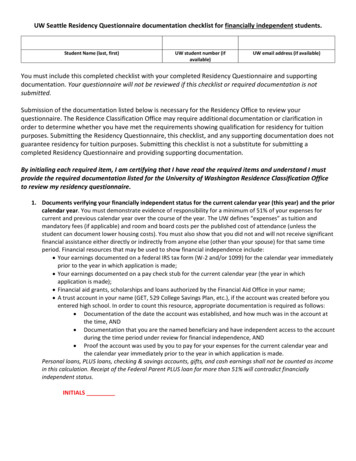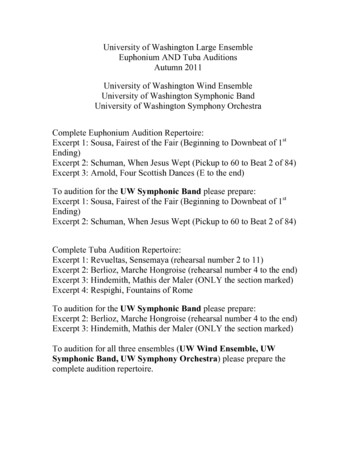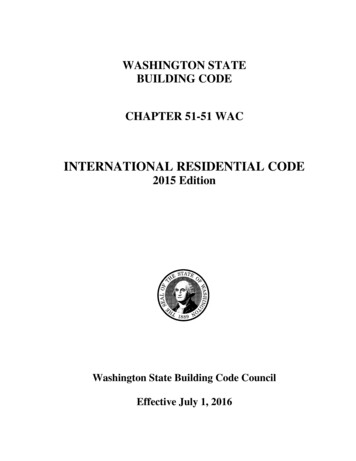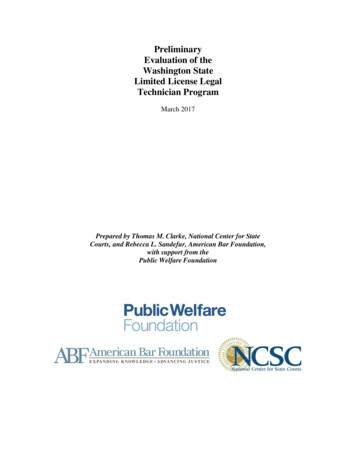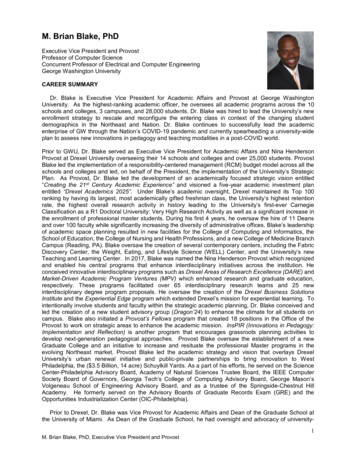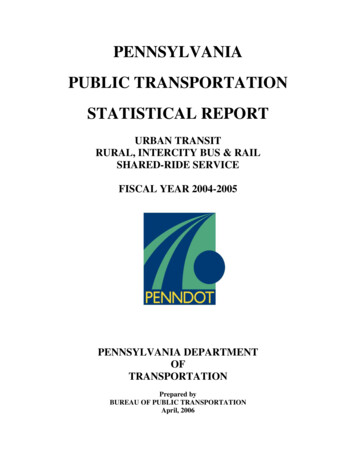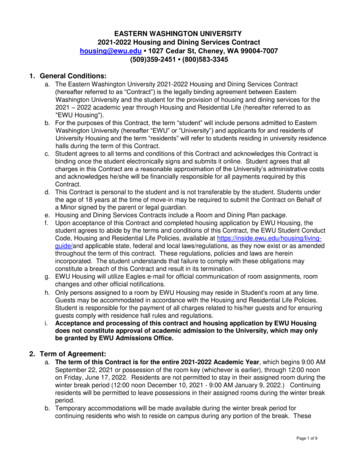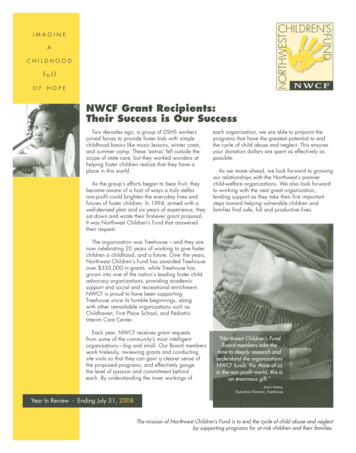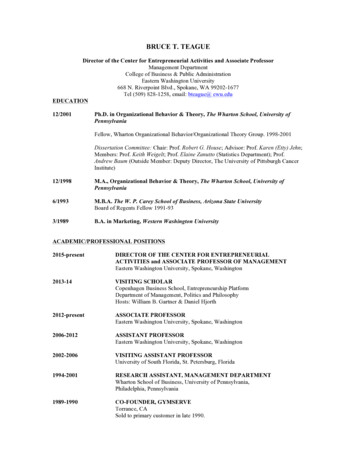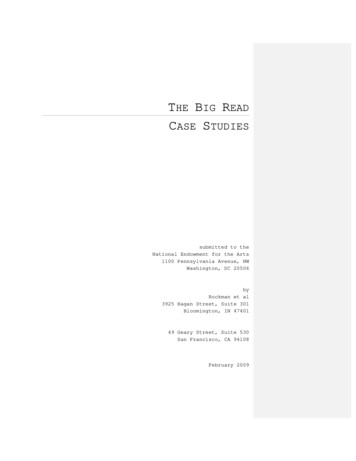
Transcription
THE BIG READCASE STUDIESsubmitted to theNational Endowment for the Arts1100 Pennsylvania Avenue, NWWashington, DC 20506byRockman et al3925 Hagan Street, Suite 301Bloomington, IN 4740149 Geary Street, Suite 530San Francisco, CA 94108February 2009
CONTENTSOverviewTrends and Themes35PHASE 1, CYCLE 110Harris County Libraries, Houston, Texas10Timberland Reads, Tumwater, Washington14City of Bridgeport, Bridgeport, Connecticut17Cumberland County Library, Fayetteville, North Carolina23National Steinbeck Center, Salinas, California29Montalvo Arts Center, Redwood City, California33The Cabin, Boise, Idaho36Mattatuck Museum, Waterbury, Connecticut41Little Traverse Bay Band of Odawa Indians, Harbor Springs, Michigan46Newport News Public Library System, Newport News, Virginia48Peoria Public Library, Peoria, Illinois51Washington University, St. Louis, Missouri55PHASE 1, CYCLE 258Berkeley Public Library, Berkeley, California58Ironwood Carnegie Library, Ironwood, MichiganHometown Perry Iowa, Perry, IowaPinellas Public Library, Clearwater, Florida73Research Foundation of SUNY, New Paltz, New York79Writers & Books, Rochester, New YorkCaldwell Public Library, Caldwell, New Jersey85Will & Company, Los Angeles, CaliforniaSpoon River College, Canton, Illinois94PHASE 2, CYCLE 161678289101National Steinbeck Center, Salinas, California101County Of Los Angeles Public Library, Los Angeles, California105Peninsula Players Theatre Foundation, Fish Creek, Wisconsin109UMass Memorial Health Care, Worcester, MassachusettsAspen Writers’ Foundation, Aspen, Colorado118Performing Arts Society of Acadiana, Inc., Lafayette, Louisiana1241142
Waukee Public Library, Waukee, IowaCumberland County Public Library, Fayetteville, North Carolina131Libraries of Eastern Oregon, Fossil, Oregon137Hartford Public Library, Hartford, Connecticut142Muncie Public Library, Muncie, IndianaTogether We Read, Asheville, North Carolina153AppendixAdministrator ProtocolLibrarian ProtocolTeacher ProtocolStudent Protocol127148158159162165169THE BIG READ CASE STUDIESOVERVIEWThe Big Read evaluation included a series of 35 case studies designed to gather more in-depthinformation on the program’s implementation and impact. In Phase 1, Cycle 1, Rockmanconducted 14 case studies, visiting 10 sites and interviewing grantees in four other sites by phone.Two of the sites we visited served as pilots, where we tested participant surveys and interviewprotocols while awaiting for approval from the Office of Management and Budget. In Phase 1,Cycle 2, we conducted nine additional case studies, five in person and four via phone. In bothcycles, we made follow-up calls, to 12 sites overall, to talk with grantees about changes andrelated activities since their Big Reads. Some grantees were in the process of applying for secondBig Read grants, and explained their choice of books, plans, and partners for the new effort.During the first cycle of Phase 2, Rockman conducted 12 cases studies, visiting eight sites andinterviewing four by phone. While we continued to talk to grantees about the basic components ofa Big Read implementation—partnerships, promotion, programming—and the program’s impacton the community, these case studies also focused on Big Read participation and reading habitsamong teenagers and young adults. In addition to conducting interviews and focus groups withteens and young adults (N 388), we also asked them to complete a checklist on reading habits andpreferences. Where possible, we also interviewed teachers, administrators, and librarians. Onecase study conducted by phone included a conversation with four students and their teachers. Twoto three months following our visits, we conducted follow-up phone interviews with four grantees.The case studies gave us a valuable first-hand look at The Big Read in context. Both formal andinformal interviews, focus groups, attendance at a wide range of events—all showed us howparticipating communities and partners host a Big Read, and what impact it has on partneringinstitutions, the broader community, and reading habits. A rich complement to the quantitativedata, these cases allowed us to explore or confirm trends emerging in the general data collection,3
document memorable events or outcomes that define the unique, local character of Big Readimplementations, and amplify elements of The Big Read that merited note or replication.The full Big Read report includes vignettes from case studies and further information on sites,sampling procedures, and research methods. A separate section reports our findings from thePhase 2 cases about reading habits and Big Read participation among teens and young adults. (SeeA Book Club for a Nation, Final Report, pp. 112-27, for a discussion of participation by teens andyoung adults, and pp.160-63 for a description of case study samples and methods.) The followingtable lists all case study sites. Interview and focus group protocols appear in the Appendix.4
The Big Read Case Studies P1C1, P1C2, and P2C1Harris Co. Libraries, Houston, TXThe Joy Luck ClubLS sites visited; interviewed byphone City of Bridgeport, Bridgeport, CTTo Kill a MockingbirdLNE My ÁntoniaMNW Their Eyes Were Watching GodMSE The Grapes of WrathMW A Farewell to ArmsMW To Kill a MockingbirdMNE Fahrenheit 451MW The Great GatsbyMM Fahrenheit 451MM Washington Univ., St. Louis, MOTheir Eyes Were Watching GodLM Newport News Public Library System, Newport News,VATheir Eyes Were Watching GodMS Little Traverse Bay Band of Odawa Indians, HarborSprings, MITo Kill a MockingbirdMM Peoria Public Library, Peoria, ILTo Kill a MockingbirdMM Caldwell Public Library, Caldwell, NJThe Age of InnocenceMNE Spoon River College, Canton, ILTo Kill a MockingbirdSM Hometown Perry Iowa, Perry, IAThe Heart Is a Lonely HunterSM Their Eyes Were Watching GodMW Will & Company, Los Angeles, CAThe Grapes of WrathLW Writers & Books, Rochester, NYThe Maltese FalconLNE SiteTimberland Regional Library, Tumwater, WACumberland Co. Library, Fayetteville, NCPhase 1, Cycle 2Phase 1, Cycle 1National Steinbeck Center, Salinas, CAThe Cabin, Boise, IDMattatuck Museum, Waterbury, CTMontalvo Arts Center, Redwood City, CAVigo Co. Library, Terre Haute, IN (pilot)Bloomington Area Arts Council, Bloomington, IN (pilot)Berkeley Public Library, Berkeley, CAPop.SizeGeog.RegionBless Me, UltimaMNE The Grapes of WrathSM Pinellas, Clearwater, FLThe Great GatsbyMS County of Los Angeles Public Library, Los Angeles, CABless Me, UltimaLW Aspen Writers’ Foundation, Aspen, COBless Me, UltimaMW National Steinbeck Center, Salinas, CAFahrenheit 451MW Cumberland Co., Public Library, Fayetteville, NCFahrenheit 451MSE My ÁntoniaLSE The Maltese FalconLNE Their Eyes Were Watching GodMS The Death of Ivan IlychMM Research Foundation of SUNY, New Paltz, NYIronwood Carnegie Library, Ironwood, MIPhase 2, Cycle 1BookTogether We Read, Asheville, NCHartford Public Library, Hartford, CTPerforming Arts Society of Acadiana, Inc., Lafayette, LAMuncie Public Library, Muncie, INWaukee Public Library, Waukee, IAPeninsula Players Theatre Foundation, Fish Creek, WIUMass Memorial Health Care, Worcester, MALibraries of Eastern Oregon, Fossil, ORThe ShawlSMPhone interview/ 4students & teacherThe Grapes of WrathSM The Heart Is a Lonely HunterMNE The Joy Luck ClubMNW Small (S) 25,000; Medium (M) 25,000-99,000; Large (L) 99,000 5
TRENDS AND THEMES1. Early Big Read promotion, where it was possible, paid off in numerous ways. It created abuzz about the program; brought partners up to speed; won the support of additionalbusiness or government groups, many of whom subsequently became involved inpromotion and programming; and drew interest and contributions from communitymembers, such as graphic artists, who offered services pro bono. This added to the base ofsupport and created momentum that could be leveraged once events got underway. Preprogramming information and promotion also allowed community members to read thebook ahead of time—especially important for a longer book or an initially challengingread like Their Eyes Were Watching God—and allowed free books and read-and-releasecopies to circulate. Advance notice also allowed some schools and book clubs that choosebooks in advance to incorporate the Big Read book into planned activities.2. In addition to museums, municipal offices, schools and universities, Big Read partnershipsincluded new, somewhat non-traditional partners—public transportation, restaurants,churches—that made important contributions to promotion and programming. In Houstonand Bridgeport, buses advertised Big Read events, as did restaurants and coffee shops,with free books, tie-in menu items, and placemats. In Waterbury, a church chamber choirled a program of music of the 1930s, along with dance and oration; in Baton Rouge,churches donated free advertising on portable billboards. In Canton, Illinois ministers infour churches delivered sermons about To Kill a Mockingbird. In one, a smaller version ofthat town’s 7-foot tall To Kill a Mockingbird replica stayed on the communion tablethroughout The Big Read.3. Newspaper partners not only sponsored and promoted events, but also explored declines inreading, Reading at Risk, and other Big Read-related issues (Terre Haute, Timberland), as wellas topics about authors, e.g., “Why We Should Read Hemingway” (Boise). In CumberlandCo., NC, a weekly column entitled “At the Library” covered Big Read events; the column waspopular—and still continues. These raised awareness about the program and the importance ofreading, and kept the community conversation going after The Big Read.4. Linking Big Read events to existing annual events, ending with celebrations, andbracketing the month-long program with festive kick-offs and finales drew crowds andbuilt continuity and sustainability. Combining their Big Read with their annualinternational festival (IFEST) worked well for Houston/Harris Co., TX; final events suchas the Steinbeck Center’s cross-generational celebration and The Cabin’s “gelato on thelawn” gave programs a festive, successful feel. Cumberland Co. had a natural audience byconcluding their program and handing out awards for art and essay contests at the wellattended Dogwood Festival; a library Summer Reading program that came right on theheels of The Big Read linked the two.6
5. Schools are a natural and frequent Big Read partner, with a ready audience, but severalgrantees found partnering with schools challenging. In some cases schools initiallyexpressed interest, and often The Big Read title was on school curriculum or optionalreading lists. The major issue is timing—and giving schools plenty of lead time—and,somewhat less so, finding the right contact and maintaining communication. For futureBig Reads, grantees will start earlier, contact superintendents and librarians as well asteachers, and invite teachers and school personnel to join planning or steering committees.Among the factors that led to successful partnerships were: long-standing relationshipswith schools (Mattatuck), latitude for schools to engage students in different ways(Bridgeport), teacher briefing/training sessions and class sets of books (Cumberland Co.),and coordinators and event leaders (e.g., seniors who read with students in alternativeschools) who are former teachers.6. Free books were hugely successful, for readers of all ages and stripes, and giving them toyouths who may never have received a free book of their own was gratifying for librariansand sponsors. Adults and seniors were as pleased as children to get reading kits; collegestudents were glad to have a book “to add to their collection.” In Harris Co., TX, Chineseand Spanish translations of The Joy Luck Club were all enthusiastically—and quickly—claimed at the kick-off. In addition to sowing seeds of a lifelong interest in reading, thefree distribution of paperbacks, Reader’s Guides, and Audio Guides built good will forsponsoring organizations and the program, which continued to spread as grantees donatedbooks that had been in circulation to schools, literacy centers, hospitals and hospices, andtroops overseas. Libraries documented increased circulation of alternative formats of theBig Read book—audio CDs, DVDs, eAudio books—during The Big Read as well.7. Along with the books, The Big Read gave community members access to free, highquality arts and literary events. Free admission to art galleries, museum exhibits, concerts,and theatre performances generated interest and audiences. Some institutions(Bridgeport’s Barnum Museum) distributed free passes at Big Read events for attendees toreturn. Bookstores also offered coupons as prizes. For some venues (e.g., Hollywood’sArclight Cinema, which offered free film screenings for the first time), this wasunprecedented.8. Although communities had some very successful events at libraries, museums, and literarycenters, many found that taking events out into the community also proved successful.Places where people gather (though not necessarily to read or discuss books)—e.g. citymarkets, floral festivals, parks, the steps of city hall—were effective, if somewhatunconventional, sites for Big Read events. Serendipitous venues where participants struckup conversations—beauty salons, grocery stores, laundromats drug stores, city buses—gave Big Reads an “anytime, anywhere” feel, and in some cases led to new book clubs,like the group of parents in Canton, IL who began a book conversation at weekly highschool basketball games.7
9. Successful implementations often seemed due to the energy, creativity, and perseveranceof a single devoted organizer. In some cases, the organizer seemed simply to have theright role and skill set—a library marketing and communications manager had the skillsand contacts to conceive, stage, and promote events. In other cases, a single vision seemedto inspire a team and get a lot of work from everyone. Finally, having the right contacts, inpartner organizations, venue sites, schools, made things work. Whoever performed orinspired the work, most grantees were surprised by the time and energy a Big Readrequired. In the future, even successful grantees said they would delegate more and/or usea train-the-trainer model. Some suggested getting “a strong team in place, then findingsomeone to manage the details.” Others will scale down events to a more manageablenumber, secure very specific expertise for various details—and find someone retired orotherwise freed up to run the project.10. The combination of the national prestige and imprimatur of the NEA, a local identity andendorsement, and repeat, high-visibility advertising helped Big Reads attract audiences.Grantees used proclamations by the mayor, recognizable officials on posters and in radiopromotion, county commissioners as kick-off speakers. Roadside and portable billboardswere also effective, as were the ongoing ads in library program fliers, newspapers, radiospots, and “What page are you on?” buttons.11. Using readings, actors, and impersonators, communities found that bringing authors to lifewas a successful promotional and programming strategy. In the case of The Cabin inBoise, ID, the Hemingway look alike drew people, and even his cardboard cut-out becamean immediately recognizable part of various Big Read events. In Timberland, aChautauqua presenter engaged Big Read audiences of all ages in conversation with WillaCather.12. Scholars and biographers were well-received, not just book-club or adult literaryaudiences but by participants of different backgrounds and ages. Again, they helped bringauthors and books to life, and often “amped up the conversation” about titles and themes.Community members seemed pleased to be engaged in higher-level discussions of books;teachers said these experts and scholars gave them new ideas about how to teach the bookand engage students. Students were often flattered to host a biographer (who often signeda book) at their school. Once engaged in a book, by this or another means, studentslistened with interest to some fairly sophisticated talks about writers and books (e.g.,scholar who talked about Steinbeck at various points in Hollywood High’s presentation ofscenes from The Grapes of Wrath).13. Displaying books and other resources about the theme or historical period of the bookgave participants more to choose from and deepened their understanding of a text. Whenthe Cumberland Co. library created bookmarks that said “If you liked Their Eyes WereWatching God ,” and listed other Harlem Renaissance authors and other recent AfricanAmerican authors, patrons took them up on the offer: one patron systematically found and8
checked out all the titles. The power of one book and the endorsement of the libraryseemed to convince readers to venture further. This site also created displays for childrenabout The Harlem Renaissance.14. Big Read communities merged literary and literacy efforts in a number of ways. They:a. designed events for young and old to bridge generational divides. These weremost effective when seniors and younger readers really interacted or workedtogether—e.g., with seniors leading discussion youth groups (and bakingcookies), or acting out scenes with younger actors, rather than just being invited tothe same event.b. took The Big Read to jails, prisons, and residential centers for encarceratedjuveniles. The most successful of these reading groups were organized byexperienced discussion leaders—e.g., teachers who had previously taught inprison programs, and required that reading groups have GEDs, to facilitatereading and discussion.c. involved audiences in non-traditional learning environments—education centersfor English Language Learners, alternative schools for students with behavioraland academic problems—and in creative activities such as art contests, talks byengaging speakers, etc. More and more, grantees seem to be including localliteracy councils in planning and programming.15. Several children’s Big Read activities also effectively drew parents, and some sites tookadvantage of this by having free books and lists of upcoming events on hand. InCumberland Co., NC, a series of “jazzy” art sessions at the museum drew good audiences;in Harris Co., TX, activities connected with a children’s companion book, Amy Tan’s,Sagwa, involved younger and older readers.16. Various data point to the fact that The Big Read has great public value, bringingcommunities together to read, reaching out across economic divides, generations, andethnicities, and in some cases “changing the conversation” about issues such as racism andgender roles. Even, in a few cases offering a tonic for sensitive topics. A very positivepublic response seems at once nostalgic, harkening back to some bygone populism, asense of togetherness, “the best thing since the WPA,” but also forward-looking, withcoffee-house readings, read-and-release distributions, poetry slams, downloadable books,and frank conversations about issues.17. The Big Read increased the visibility of libraries, museums, and literary centers,showcasing resources and helping restore the role of the institutions in American cultureas well as the literature itself. The program also seems to be redefining roles. Librarianssay they’ve reframed or expanded outreach, including hospices, for example. Some have9
planned in-services for area teachers to introduce them to resources and databases. Morecommunity members see libraries and other institutions not just as book or artifactrepositories but also event centers. New partnerships and cross-promotion compoundthose positive changes.18. Most all proposal authors explained that they chose their book because they thought itsthemes would resonate in their communities. What’s striking is the variety in howcommunities explored these themes. Harper Lee biographer, Charles Shields, who hasbeen to numerous towns reading To Kill a Mockingbird, said, “I haven’t seen any twocommunities offer the same menu of programs.” The book worked as well for small-townIllinois as for a tribal community, for a small, southern town as for a northern urban area.Elders and children in Little Traverse Bay and ELL mothers in Bridgeport talked about thebook’s view on the moral education of children. Hispanic students in LA were as movedby Steinbeck’s story of migrant families as seniors in Arkansas remembering the DustBowl. It goes without saying that this is why these books endure, but it’s nice to see itplayed out over and over again.10
PHASE 1, CYCLE 1Harris County Public Library, Houston, TexasThe Joy Luck ClubRegion: SouthNumber of K-12 Schools: 15Total Days: 41Military Base: NoNumber of Teachers: 150Population: 1,300,000 (Large)Number of Partner Organizations: 14Number of Libraries: 6Number of Museums: 1Number of Volunteers: 300Number of Events: 148Number of Attendees: 18,179Adults, 9,768; Children 8,411Number of Book Club Meetings: 59Number of Book Club Attendees: 461Adults, 431; Children 30Harris County Public Libraries, in Houston, Texas, kicked off The Big Read at Houston’s popularInternational Festival, handing out hundreds of free copies of The Joy Luck Club. As part of theInternational Festival’s city-wide, month-long celebration of China, The Big Read contributed a literaryfocus, engaging participants around the city in conversations about culture, gender, generationalrelationships, language, and immigration.BackgroundThe Harris County Big Read Kick-off was planned in conjunction with Houston’s annualInternational Festival. This year’s festival celebrated China, which informed Harris County’s choiceof the Joy Luck Club as their Big Read book. Kicking off The Big Read at an established event thatattracted thousands of people and already included multiple events proved to be an effectiveprogramming strategy. The partnership between the library and the city’s Asian Pacific AmericanHeritage Association—their first—was a key to The Big Read’s success. By bringing together theirrespective partners and contacts, a sizeable and diverse group of organizations and agencies were ableto implement a wide range of events and reach a broad demographic.PartnershipsIn her early planning meetings with potential partners, the director of the Harris County Big Readsaid she spent a lot of time educating others about the national Big Read program. However, onceinformed, partners were hooked, and contributed in effective and sometimes surprising ways. Forinstance, Metro, the city’s public transportation system, created buttons, Big Read fortune cookies,and bilingual pamphlets listing Big Read events with a transit map highlighting bus routes to thoseevents. Another partner new to the library was the local PBS station. It was their idea to draw inyoung children and their parents through promoting Sagwa, the television series based on AmyTan’s children’s book Sagwa, the Chinese Siamese Cat. They provided materials and training toany elementary school librarians who were interested. Eager to participate more fully in The BigRead and the city’s International Festival, many took them up on the offer.11
The Big Read program director took an open and flexible approach to partnerships: “We’re reallythe conduit,” she said. “We received the grant to help them do the program.” Partners were givenplenty of room to conceive of the program on their own terms. Building capacity was anunanticipated outcome for Harris County Public library; they felt they were able to demonstratetheir value to other city organizations as an effective point of contact with the public, a place tohold community events, and a strategic partner in city initiatives.Programming and ParticipationHarris County Libraries is a 27-branch system that encompasses Houston; it is one of the largesturban counties in the U.S. As part of The Big Read, each library in the county was required to hostone book discussion. One branch held a training session for book discussion leaders that wasattended by 61 people. While the library anticipated drawing those new to book clubs, they foundmany existing book club participants came to be sure they were doing it “right,” and get ideas. Thelibrary was excited to make that connection to community books clubs, and center the library morein those events. However, the session successfully trained those who began book clubs as aresult—including several librarians.Branch libraries also hosted discussions of Joy Luck Club in Chinese and Spanish. The Chinesebook discussion was held in a home and attracted participants who were not library patrons. Yet,many of those participants then came to the library’s next Big Read event. Another powerfulinstance of a new book club arising from The Big Read was at the South Houston Library branch,a busy neighborhood library that serves a predominantly Hispanic community. There, six Spanishspeaking Mexican-American women participated in their first book club, having been personallyinvited by the bilingual librarian when she gave each her free copy of the book and Reader’sGuide. The discussion began with the showing of the short wordless film, Perfection. The filmspurred an animated discussion, with the women quickly making connections to the book and theirpersonal experiences. Although not acquainted with one another before that evening, the womentold stories, laughed, disagreed, and realized their shared experiences as women, mothers, andimmigrants—even though there was a wide span in age. All expressed their appreciation to thelibrarian and their eagerness to take part in another meeting.Sixty-two school districts were invited to participate in the program, but The Big Read programdirector received little response. She knew it would be difficult to “sell” in May. However, in onesuburban Houston school district, students of all ages participated in The Big Read. At the highschool an English teacher who taught Joy Luck Club in a Gifted and Talented 10th grade classcreated an assignment of her own around the book, which she called a “character autopsy.” Thehigh school librarian reported several students had come to the library to request copies of thebook. In elementary schools, the librarians were reading Sagwa, the Chinese Siamese Cat by AmyTan as part of The Big Read and the city’s focus on China.Harris County also effectively engaged the community college system in The Big Read. Two ofMontgomery College’s five campuses have public libraries. One campus hosted a Keynotediscussion with a panel of international authors that drew a crowd of 200 people. The discussion12
illustrated the universal and cross-generational themes of the book, as discussants identified thesimilar ways they responded to themes in the book, despite their diverse nationalities. Anothercampus held a tea ceremony and book discussion where an international student from Chinabrought her Chinese tea set and demonstrated how to make and serve tea in the same way she hadlearned from her mother and grandmother. Events at the community college level weresuccessfully attracting international students, non-traditional students, staff, and faculty.According to the Harris County Big Read director, adults in the Lifelong Learning program alsoresponded well to Big Read events.Promotion and MediaHarris County produced many of their own promotional materials—an event calendar, buttons,bookmarks, pamphlets, fans, fortune cookies—in addition to those provided by The Big Read. ThePSAs were delivered to Time Warner and three television stations and was hosted on the grantee’sweb site via YouTube. The program director heard from just a few who had seen the PSA ontelevision; many more had commented on the YouTube video. In an effort to disseminatematerials to a wide demographic, thirty-six boxes of Reader’s Guides were distributed to groceryshoppers by Randall’s Safeways. Harris County would also have benefited from Reader’s Guidespublished in Spanish. Securing enough copies of the book was difficult, especially large printcopies, unabridged audio editions, and translations in Spanish and Chinese. All were in highdemand. The library also has an “Over Drive” program with downloadable books, popular withcommuters.All of the branch libraries featured Big Read displays. Again, the program director encouraged thelibraries to be creative and left them to find ways to connect the book with their particularaudiences. Branches displayed Chinese artifacts—ceramic fu dogs, bonsai trees, batik art,Cheongsam and Chinese jackets, for example. One library featured their Big Read display in thechildren’s section to attract the attention of adults who come to the library with their children.ImpactIt was apparent that The Joy Luck Club was an exceptionally good fit for a county library systemthat serves a diverse city like Houston, Texas. Readers related to the themes of immigration,language, culture, and Eastern/Western differences and their impact on cross-generationalrelationships. In discussions that transcended ethnic and national differences, women talked aboutthe mother-daughter relationships at the heart of the novel. The Big Read director noted that“people really related to The Joy Luck Club and the universal themes in it. It showed all peopleshare similar experiences.”A few months after their Big Read program had ended, Harris County reported that more brancheshad begun book clubs for Spanish speakers, inspired by the successful event in south Houston.Three months after their Big Read, the program director was excited that the local PBS station hadcome back to Harris County Public Libraries to ask for their partnership in promoting their newchildren’s show Super WHY! by holding Super WHY! Story times. Ameagy Bank, another first13
time partner, became a Friend of one library branch, committing 500 to sponsor their HispanicHeritage Festival. The Big Read resulted in a big increase in the number of events and programattendees during a typically slow libr
Site Book Pop. Size Geog. Region sites visited; interviewed by phone Phase 1, Cycle 1 Harris Co. Libraries, Houston, TX The Joy Luck Club L S City of Bridgeport, Bridgeport, CT To Kill a Mockingbird L NE
